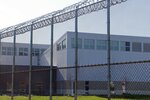

Editor’s note: This is the second installment in a two-part series on Green Hill School. To read the first article, visit https://tinyurl.com/2f8pvkhc.
Despite criticism, on a recent tour of the facility Green Hill School Interim Superintendent Jason Aldana said the focus remains on setting young offenders on a new and better path.
“We're going to continue to do the fight and try to make this the best place it can be. Things are gonna happen. We're going to be transparent about it. We are going to address them. We're going to try to make changes that we think will benefit(residents),” Aldana said. “And they're young. It's rehabilitation for a reason, and redemption for our guys here. So we believe in the work that we're doing, and our staff are in the fight with it every day.”
A juvenile detention and rehabilitation system operated by the state Department of Children, Youth and Families (DCYF), Green Hill has come under scrutiny from both law enforcement and lawmakers.
Most frequently, the attacks have centered around highly publicized incidents of staff misconduct and contraband, as the state adjusts to new rules to allow some young offenders to remain at the facility for longer.
In recent years, Washington state has invested in treatment services and infrastructure improvements as lawmakers look to reduce recidivism.
“We’ve had some staff that weren't living up to our standards and expectations,” Aldana said. “But that is not what the average staff member is here. They come in here to do a job to try to change people's lives and to make a difference in the lives of our residents and set them up for success.”
JR to 25
Passed by the Legislature in 2018, JR to 25 allows some sentenced for crimes committed under 18 years old to serve time in juvenile rehabilitation facilities such as Green Hill until they are 25.
The legislation inspired hope among some lawmakers that by housing young offenders in youth detention facilities, they could decrease the likelihood of those youth reoffending, as residents would no longer be transferred to the Department of Corrections on their 21st birthday to serve the remainder of their sentence.
“This is a very important bill because we think it will help young people avoid recidivism, help our communities by reducing crime and recognize the ambitions of youth who we understand have positive futures,” Gov. Jay Inslee said during a ceremonial bill signing. “This bill makes a number of changes to the juvenile justice system to line up with evolving brain science and provide more discretion in sentencing youth.”
But it wasn’t without its detractors.
“Majority Democrats who passed the law — which you signed and I opposed — made a huge mistake. Adults do not belong locked up with children,” Senate Minority Leader John Braun, R-Centralia, wrote in a Feb. 9 letter to Inslee. “Since that’s not likely to change, the challenge is for you to make it work. The change in law that moved adults to Green Hill School was poorly implemented and what we are seeing now is the disastrous fallout.”
According to a spokesman for the governor, the legislation required a “transformational shift in operations and facilities planning” at youth detention facilities, with the facility continuously looking at potential site improvements.
“It is absolutely true that House Bill 6160 (also referred to as JR to 25) and the fentanyl crisis have impacted conditions at Green Hill,” Inslee wrote in a Feb. 22 letter to Braun. “Should you choose to become more informed and visit Green Hill School to speak with their leaders, they could talk to you about their ongoing collaboration with the Chehalis Police Department and how they have enacted all their suggested reforms to date.”
The legislation took effect in July 2019, months before COVID restrictions slowed intakes in both youth and adult facilities across the state. During the pandemic, Green Hill School’s campus averaged between 120 and 140 residents. Echo Glen Children's Center, a youth detention facility located near Snoqualmie Pass, averaged around 60 inmates during that time.
Green Hill now houses more than 200 residents, a figure staff members said exceeds best practices, particularly for young offenders.
“And I think that's one of the realities we're grappling with and beginning to unpack what that means both from infrastructure — so you see some of the security changes a period of older populations, more visitors coming, different types of visitors, spouses, others will visit older kids,” said Allison Krutsinger, director of public affairs for DCYF. “So you see some of those changes up here that have happened.”
In one of her first moves with DCYF, Krutsinger said she secured capital funding for a new recreation center on the campus, a building that opened last summer.
“This is probably one of the most significant improvements related to JR to 25 coming online,” she said. “The old rec center had lots of blind spots and was very small.”
The new facility is a net zero-emission building, powered by solar panels. Grass on the grounds is watered by an onsite water reserve, and the new gym costs about 80 cents a month to operate.
The facility is complete with a practice kitchen, a gymnasium, a weight room and a staging area where the facility can host graduations.
“When you think about the number of kids here, young people, physical activity is one of the best methods for engaging (them),” Krutsinger said. “So this is probably one of the most significant changes to the campus.”
According to Krutsinger, DCYF continues to explore additional investments and upgrades at Green Hill and other facilities “to both manage the safety and security, the basic infrastructure that is necessary, but also the programming, the support, and treatment. This is really about rehabilitation.”
Krutsinger said the agency will likely make additional recommendations for funding to support improvements to technology and infrastructure.
“I have a strong interest in ensuring a safe environment for Green Hill School’s youth and employees, and promoting positive rehabilitation outcomes for the youth at all our juvenile rehabilitation facilities,” Inslee wrote in the Feb. 22 letter. “I cannot imagine anyone whose heart does not break at the news of a young person — whatever their circumstances — grappling with substance use issues or trying to escape a dangerous cycle of violence.”
Services
While at the facility, residents can study for their associate or bachelor’s degrees through Centralia College, with Aldana noting a group of the residents placed on the dean’s list. Later this year, the facility will celebrate the first residents who obtained their bachelor’s degree while at the facility.
“The partnership with Centralia College has been great,” Aldean said. “They're great partners for us and are great partners for our youth.”
The courses began in the summer of 2019 after state legislative work groups identified college as one of the main programs juvenile offenders were interested in, and expanded into a partnership between the college and Green Hill in the spring of 2020.
As of January 2022, the courses available to Green Hill residents included everything needed to complete an associate degree.
The first student to complete an associate in arts degree did so in June 2022.
“The program aims to help youth transition to college and job training programs, and improve their chances of success upon reentry,” a Centralia College spokesperson said in an email to The Chronicle following a December 2022 graduation ceremony.
Green Hill also offers vocational programs like cosmetology, carpentry or car maintenance, in the hopes of preparing young offenders for life outside of the facility, in industries that have been historically more willing to take a chance on applicants with criminal records.
“We need to find opportunities for our guys that they can actually use,” Aldana said.
The facility offers other programs designed to increase resident engagement and promote a more positive environment.
Seattle Rapper Macklemore visited the facility last month in support of a resident-created fentanyl-awareness music video in partnership with The Bridge Music Project for the SAMHSA Fentanyl Awareness Youth Challenge.
“This was our first time connecting with Macklemore, and we just felt thrilled that he came through and showed his support for the music video and for the youth who are in addiction recovery. It really meant a lot to everyone,” said The Bridge Music Project Executive Director Bobby Williams.